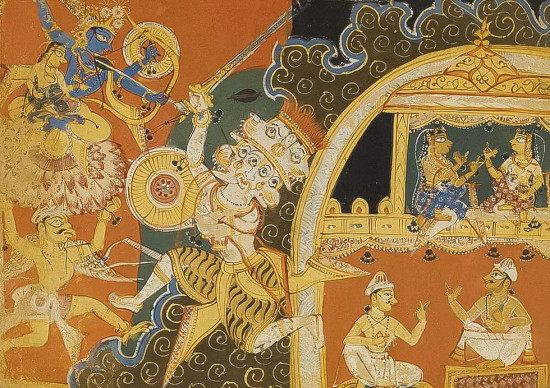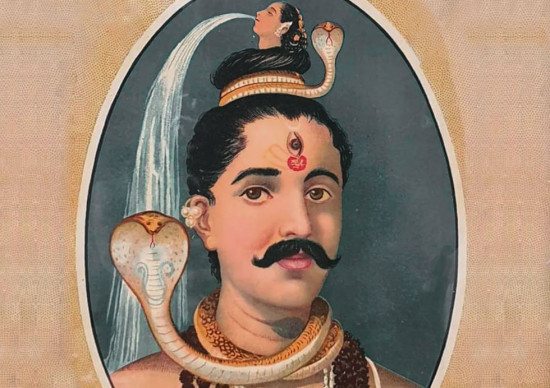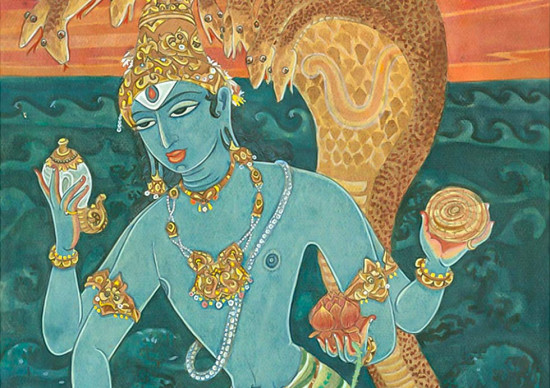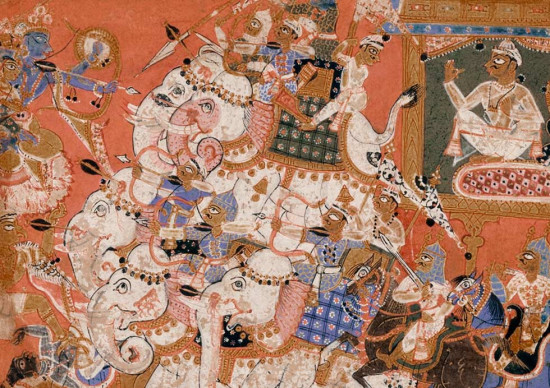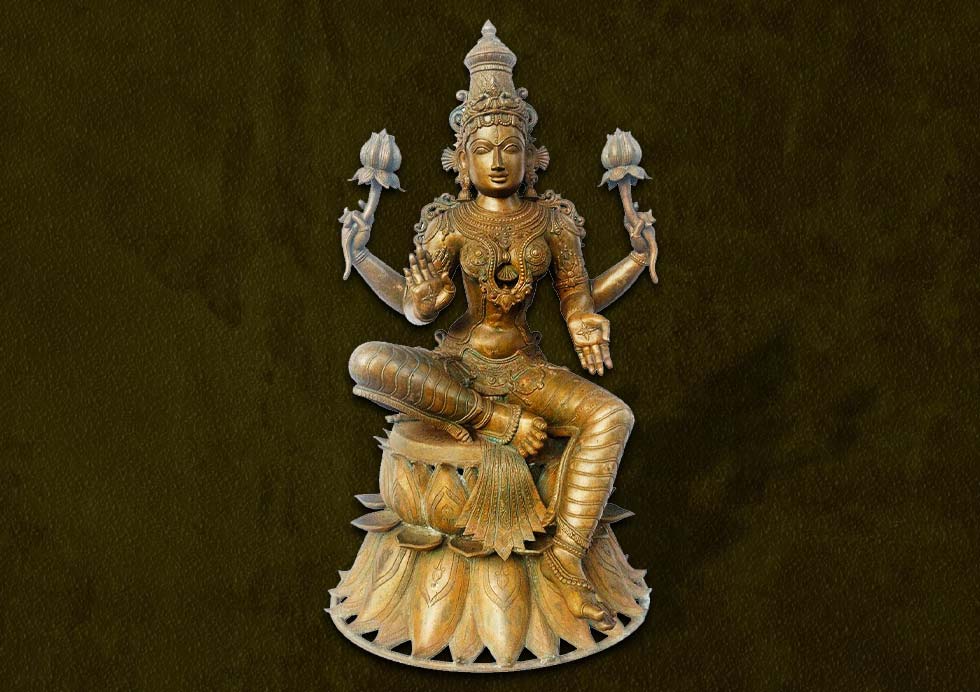
Adorned in a vibrant red saree, shimmering with gold ornaments, Lakshmi, the embodiment of prosperity, sits serenely upon a lotus flower. A radiant smile graced her lips, radiating warmth and benevolence. In her two upper hands, she cradles delicate lotus blossoms, symbols of purity and spiritual growth. Her lower right hand overflows with a golden pot, brimming with the bounty of the universe. With her outstretched left hand, she bestows blessings upon her devotees, offering the promise of abundance and fulfillment. Every detail, from the vibrant hues to the gentle gesture of blessing, speaks of Lakshmi’s divine presence, a beacon of hope and prosperity for all who seek her grace.
This captivating image, etched in the minds of millions, is but a glimpse into the enchanting story of Lakshmi’s emergence. Her tale, deeply woven into the fabric of Hindu literature, transcends mere imagery, offering profound insights into the nature of prosperity and its manifestation in our lives.
The story of Lakshmi, the goddess of prosperity, is deeply connected to a grand event in Hindu mythology called the Samudra Manthan. This event, literally meaning “churning of the ocean,” is a tale of collaboration and conflict between gods and demons.
It all began when the powerful ruler of the heavens, Indra, accidentally offended a wise sage named Durvasa. Upset by Indra’s disrespect, Durvasa cursed him to lose his divine powers. This meant trouble for Indra and the other gods, as they needed their powers to maintain order and protect the world.
The incident unfolded when Rishi Durvasa offered a garland, initially given by an apsara, to Indra as a sign of respect. However, Indra placed the garland on his mount Airavat’s trunk. The fragrant flowers attract bees, causing irritation to Airavat, who tossed the garland to the ground. Observing this, Rishi Durvasa became furious, as the garland was the abode of Sri, the goddess of fortune. The goddess, Lakshmi, who resided in the garland, disappeared into the ocean. In his anger, Durvasa cursed Devraj Indra and the Devas, causing them to lose their divine abilities.
This captivating image, etched in the minds of millions, is but a glimpse into the enchanting story of Lakshmi’s emergence. Her tale, deeply woven into the fabric of Hindu literature, transcends mere imagery, offering profound insights into the nature of prosperity and its manifestation in our lives.
The story of Lakshmi, the goddess of prosperity, is deeply connected to a grand event in Hindu mythology called the Samudra Manthan. This event, literally meaning “churning of the ocean,” is a tale of collaboration and conflict between gods and demons.
It all began when the powerful ruler of the heavens, Indra, accidentally offended a wise sage named Durvasa. Upset by Indra’s disrespect, Durvasa cursed him to lose his divine powers. This meant trouble for Indra and the other gods, as they needed their powers to maintain order and protect the world.
The incident unfolded when Rishi Durvasa offered a garland, initially given by an apsara, to Indra as a sign of respect. However, Indra placed the garland on his mount Airavat’s trunk. The fragrant flowers attract bees, causing irritation to Airavat, who tossed the garland to the ground. Observing this, Rishi Durvasa became furious, as the garland was the abode of Sri, the goddess of fortune. The goddess, Lakshmi, who resided in the garland, disappeared into the ocean. In his anger, Durvasa cursed Devraj Indra and the Devas, causing them to lose their divine abilities.

Determined to regain their strength, the gods and demons joined forces to churn the cosmic ocean of milk. They believed that this churning would release powerful treasures, including the elixir of immortality. As they churned with a giant serpent “Vasuki” as their rope, various magical things emerged from the ocean depths. Prior to the emergence of Amrita, numerous jewels and precious items surfaced from the Samudra Manthan, including:
- Kamdhenu the wish granting cow
- Apasaras (damsels)
- Varuni the goddess of wine
- Uchhaishravas: the divine seven-headed horse, given to Bali.
- Kaustubha: the most valuable ratnam (divine jewel) in the universe, claimed by Vishnu.
- Kalpavriksha: a divine wish-fulfilling and flowering tree with blossoms that never fade or wilt, taken to Indraloka by the devas.
- Sharanga: a powerful bow, given to Vishnu.
- Additionally produced were:
- Chandra: a crescent, claimed by Shiva.
- Dhanvantari: the “vaidya of the devas” with amrita, the nectar of immortality. (Sometimes considered as two separate Ratnas)
- Halahala: the poison swallowed by Lord Shiva (after drinking this lord shiva becomes nilkantha).
- This list varies among the different Puranas and it is also slightly different in the Ramayana and Mahabharata.
- Panchajanya: Vishnu’s conch
- Jyestha (Alakshmi): the goddess of misfortune
- The umbrella taken by Varuna
- The earrings given to Aditi by her son Indra
- Nidra Devi, goddess of sleep
Among these treasures, a radiant goddess rose from the churning milk, bringing with her an aura of prosperity and fortune. This was Goddess Lakshmi, the goddess who had vanished into the ocean after being disrespected by Indra.
Apsaras, the dancing maidens, adorned the atmosphere with their graceful dance, concluding by presenting a garland to the goddess.
In those times, the tradition of ‘swayamvara’ allowed a woman to choose her own husband. Devas, Asuras, and even Lord Vishnu in his human form eagerly awaited Devi Lakshmi’s decision, each wondering who would be the chosen one.
Apsaras, the dancing maidens, adorned the atmosphere with their graceful dance, concluding by presenting a garland to the goddess.
In those times, the tradition of ‘swayamvara’ allowed a woman to choose her own husband. Devas, Asuras, and even Lord Vishnu in his human form eagerly awaited Devi Lakshmi’s decision, each wondering who would be the chosen one.
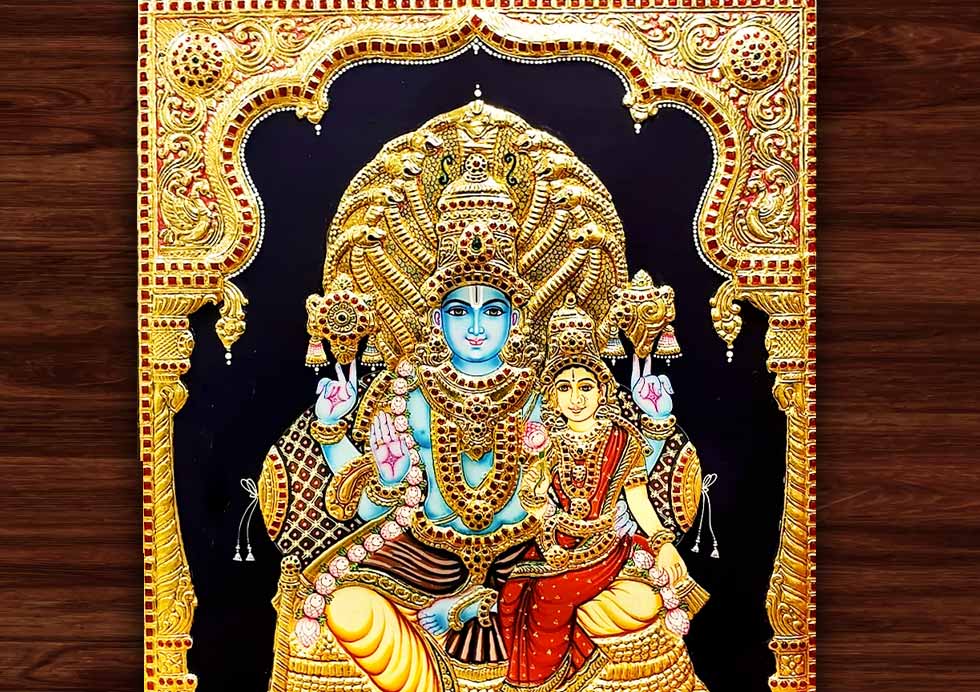
Observing the assembly of Devas and Asuras, Goddess Lakshmi’s gaze fell upon Lord Vishnu. His beautiful twinkling eyes and mischievous smile caught her attention. With a gentle smile, she garlanded Lord Vishnu, selecting him above all others.
The cheers of the Gods resonated as Goddess Lakshmi wed Lord Vishnu. She, the Goddess of Wealth and Prosperity, and he, the Preserving God, manifested a divine union. The onlookers sensed her as the Supreme Goddess, choosing to become Lord Vishnu’s wife, embodying his power and strength.
Amidst grandeur, Lakshmi and Vishnu were united during the churning of the ocean. Vishnu, now known as Shreenatha (beloved of fortune), adorned Shreevasta, the symbol of Lakshmi, on his chest. As Vishnu carried out his duties as the guardian of the world, battling forces of evil, Lakshmi showered him with love and affection, standing by him as a devoted wife.
The cheers of the Gods resonated as Goddess Lakshmi wed Lord Vishnu. She, the Goddess of Wealth and Prosperity, and he, the Preserving God, manifested a divine union. The onlookers sensed her as the Supreme Goddess, choosing to become Lord Vishnu’s wife, embodying his power and strength.
Amidst grandeur, Lakshmi and Vishnu were united during the churning of the ocean. Vishnu, now known as Shreenatha (beloved of fortune), adorned Shreevasta, the symbol of Lakshmi, on his chest. As Vishnu carried out his duties as the guardian of the world, battling forces of evil, Lakshmi showered him with love and affection, standing by him as a devoted wife.
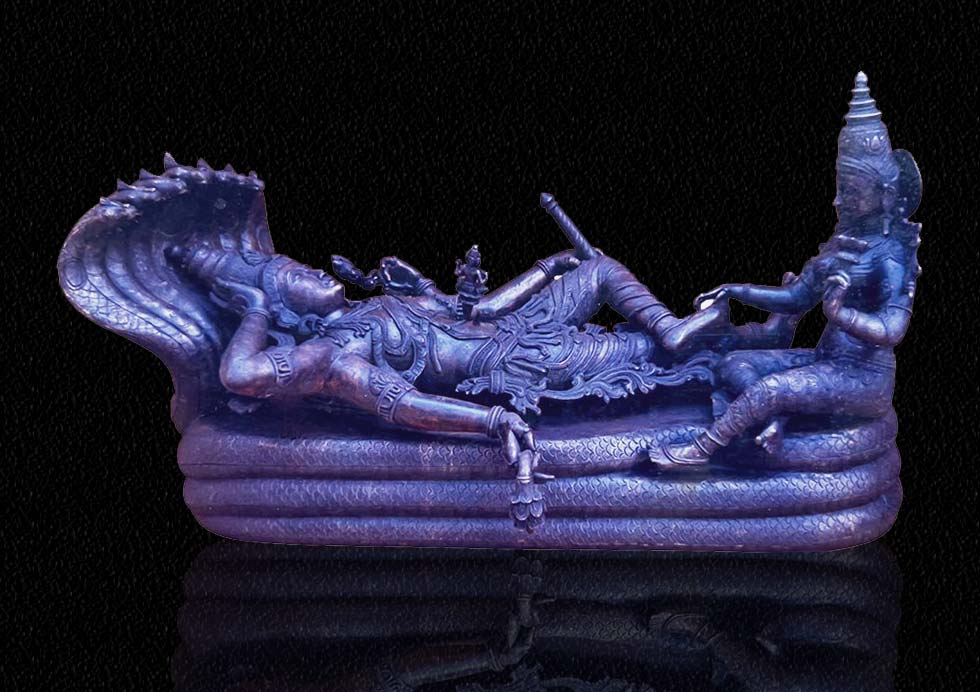
Lakshmi’s emergence from the ocean symbolizes the potential for abundance and good fortune that exists within the world. It reminds us that even in times of struggle and collaboration, positive outcomes can emerge, bringing blessings and prosperity.
Goddess Lakshmi the goddess of wealth
People worship Goddess Lakshmi because she is believed to be the goddess of wealth and prosperity in Hinduism. People seek her blessings to gain financial stability and abundance in their lives. Devotees believe that worshiping her brings good luck and success. Goddess Lakshmi is also revered for her qualities of generosity and kindness. Devotees believe that by worshiping her, they not only gain material wealth but also spiritual wealth and well-being. People express their gratitude and seek her blessings through prayers and rituals, hoping for a life filled with prosperity and happiness.

